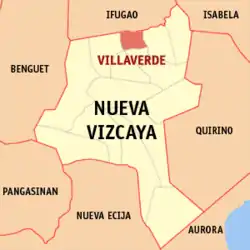Villaverde, Nueva Vizcaya
Villaverde, officially the Municipality of Villaverde (Ilocano: Ili ti Aritao; Tagalog: Bayan ng Aritao), also spelled as Villa Verde, is a 5th class municipality in the province of Nueva Vizcaya, Philippines. According to the 2015 census, it has a population of 18,507 people. [3]
Villaverde | |
|---|---|
| Municipality of Villaverde | |
 Municipal Hall | |
 Seal | |
 Map of Nueva Vizcaya with Villaverde highlighted | |
OpenStreetMap 
| |
.svg.png.webp) Villaverde Location within the Philippines | |
| Coordinates: 16°35′N 121°12′E | |
| Country | |
| Region | Cagayan Valley (Region II) |
| Province | Nueva Vizcaya |
| District | Lone district |
| Barangays | 9 (see Barangays) |
| Government | |
| • Type | Sangguniang Bayan |
| • Mayor | William P. Tugangui |
| • Vice Mayor | Ronelie U. Valtoribio |
| • Representative | Luisa L. Cuaresma |
| • Electorate | 11,588 voters (2019) |
| Area | |
| • Total | 81.50 km2 (31.47 sq mi) |
| Elevation | 287 m (942 ft) |
| Population | |
| • Total | 18,507 |
| • Density | 230/km2 (590/sq mi) |
| • Households | 4,439 |
| Economy | |
| • Income class | 5th municipal income class |
| • Poverty incidence | 9.75% (2015)[4] |
| • Revenue | ₱62,477,015.32 (2016) |
| Time zone | UTC+8 (PST) |
| ZIP code | 3710 |
| PSGC | |
| IDD : area code | +63 (0)78 |
| Climate type | tropical rainforest climate |
| Native languages | Ilocano Tagalog |
| Website | www |
History
Villaverde was formerly a barrio of Solano, Nueva Vizcaya called Ibung, founded by a Dominican Friar named Alejandro Vidal in 1767. More than a century later, an order from the Spanish Government was issued to Father Juan Villaverde giving instruction to organize into a town. Thus, on May 28, 1872, Ibung became a town of the province of Nueva Vizcaya.
When the American took over the reins of Government in the country, Ibung lost its identity as a town because of insufficient funds. Moreover, most of the people residing in the area have transferred to an adjoining towns for fear of their lives from barbarics non-Christian tribes who dwelt in the mountain fastness of the cordillera mountains in the north-west part of the town. Thus, the populated was reduced, Ibung, then, became again a mere barangay of the municipality of Solano.
On June 17, 1957, through the sponsorship of the Congressman Leonardo B. Perez, Republic Act. No. 197 was enacted providing for the creation of the town Ibung through the separation of the barrios of Ibung and Bintawan from Solano.[5] Thus, on September 1, 1957, Antonio B. Aquino was appointed as the first Municipal Mayor of the town Ibung.
Two years later, on June 21, 1959, Republic Act. No. 2515 was enacted amending Republic Act. No. 1972 changing the name of IBUNG to VILLAVERDE in honor of the Spanish Missionary, father Juan Villaverde who had initiated the first stepin creation of the town. Romualdo Ubando was appointed as the first Municipal Mayor. In 1963 Antonio B. Aquino was the first elected Mayor.
Geography
About 280 kilometres (170 mi) from Manila and 14 kilometres (8.7 mi) from the capital town of Bayombong; lies on the northern district of the province and is bounded by Lamut, Ifugao on the North; Solano on the South; Bagabag on the East, and Ambaguio on the West. Villaverde has a total land area of 81.50 square kilometers, the smallest town which accounts for 1.86% of the total land area of Nueva Vizcaya.
Barangays
Villaverde is politically subdivided into 9 barangays, with Barangay Poblacion were the Municipal Hall stands and Barangay Ibung, Bintawan Norte and Bintawan Sur as the commercial and educational center of the town.
- Bintawan Sur
- Ibung
- Cabuluan
- Nagbitin
- Ocapon
- Pieza
- Sawmill
- Poblacion (Turod)
- Bintawan Norte
Demographics
| Year | Pop. | ±% p.a. |
|---|---|---|
| 1960 | 7,120 | — |
| 1970 | 8,709 | +2.03% |
| 1975 | 10,590 | +4.00% |
| 1980 | 10,644 | +0.10% |
| 1990 | 13,594 | +2.48% |
| 1995 | 13,431 | −0.23% |
| 2000 | 15,392 | +2.96% |
| 2007 | 16,623 | +1.07% |
| 2010 | 17,720 | +2.35% |
| 2015 | 18,507 | +0.83% |
| Source: Philippine Statistics Authority [3] [6] [7][8] | ||
Education
Secondary schools:
- Bintawan National High School
- Our Lady of Fatima School of Villaverde
References
- Municipality of Villaverde | (DILG)
- "Province: Nueva Vizcaya". PSGC Interactive. Quezon City, Philippines: Philippine Statistics Authority. Retrieved 12 November 2016.
- Census of Population (2015). "Region II (Cagayan Valley)". Total Population by Province, City, Municipality and Barangay. PSA. Retrieved 20 June 2016.
- "PSA releases the 2015 Municipal and City Level Poverty Estimates". Quezon City, Philippines. Retrieved 1 January 2020.
- "An Act Creating the Municipality of Ibung, Province of Nueva Vizcaya". LawPH.com. Retrieved 2011-04-13.
- Census of Population and Housing (2010). "Region II (Cagayan Valley)". Total Population by Province, City, Municipality and Barangay. NSO. Retrieved 29 June 2016.
- Censuses of Population (1903–2007). "Region II (Cagayan Valley)". Table 1. Population Enumerated in Various Censuses by Province/Highly Urbanized City: 1903 to 2007. NSO.
- "Province of Nueva Vizcaya". Municipality Population Data. Local Water Utilities Administration Research Division. Retrieved 17 December 2016.
External links
| Wikimedia Commons has media related to Villaverde, Nueva Vizcaya. |
